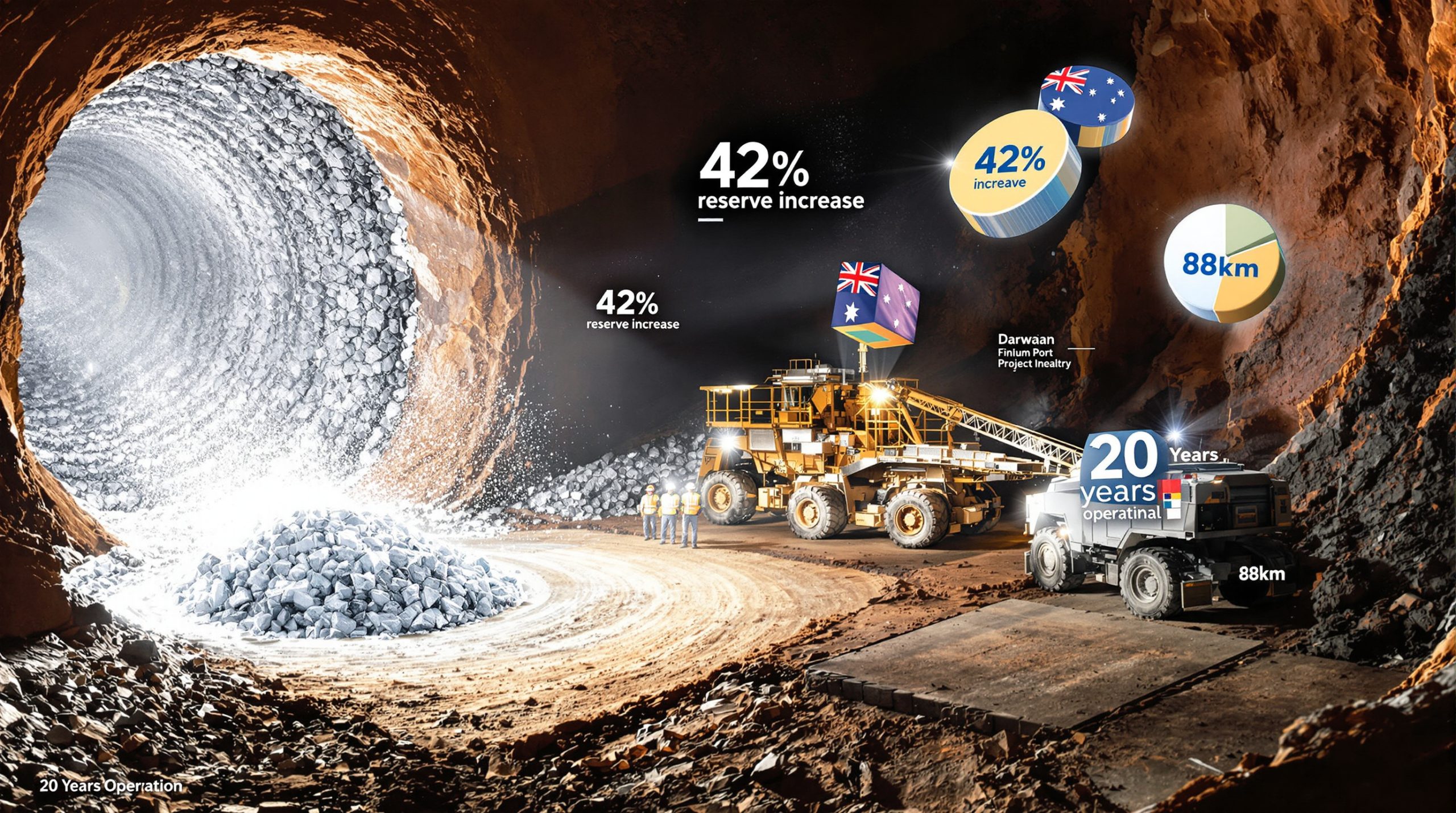Australia's Gold Export Boom: Economic Impact and Future Outlook
Australia's gold export sector is experiencing a remarkable surge, reshaping the country's economic landscape and creating substantial revenue streams. With unprecedented growth in both production and global prices, gold is poised to become Australia's second-largest export commodity, delivering significant benefits to the national economy and regional communities.
How is Australia's Gold Export Sector Performing?
The performance of Australia's gold export sector has reached extraordinary heights, with earnings skyrocketing by 42% in 2024-25 to reach $47 billion. Industry forecasts project an additional 28% increase to $60 billion in 2025-26, positioning gold as Australia's second-largest national export commodity. This dramatic growth trajectory represents what industry experts characterize as a "major economic windfall" for the Australian economy.
The gold sector's current performance marks the highest export values in Australian mining history, far outpacing previous records. This exceptional growth comes after steadier performance in previous years, with gold exports valued at approximately $33 billion in 2022-23, according to the Department of Industry, Science and Resources.
Key Export Growth Statistics
| Period | Export Value | Percentage Growth |
|---|---|---|
| 2024-25 | $47 billion | 42% increase |
| 2025-26 (forecast) | $60 billion | 28% additional growth |
| 2026-27 | Expected stabilization | – |
Australia maintains its position as the world's second-largest gold producer after China, contributing approximately 9% of global gold mine production. This significant market share underpins Australia's influence in global gold markets and supports the country's export growth potential.
What's Driving the Gold Export Rise?
The extraordinary performance of Australia's gold export sector can be attributed to two primary factors: unprecedented global gold prices and expanding domestic production capacity. These complementary drivers have created ideal conditions for export growth.
Record-Breaking Global Gold Prices
Gold prices have reached historic levels in international markets, creating exceptionally favorable conditions for Australian exporters:
- Prices exceeded $US3,700 per ounce in mid-September 2025
- Gold hit a historic milestone of $US4,000 per ounce in October 2025
- Forecasts suggest prices will remain above $US3,200 per ounce throughout the forecast period
- Current prices represent approximately 106% increase from 2020 levels
This remarkable price performance represents a significant premium over historical averages. For context, gold averaged $US1,770 per ounce in 2020 and $US1,940 per ounce in 2023, according to World Gold Council data. The current price environment creates substantial profit margins for Australian producers.
Australian miners benefit from a dual advantage in this high-price environment. Not only do they receive higher USD prices for their gold, but any weakness in the Australian dollar multiplies this effect. When gold trades at $US4,000 per ounce with an AUD/USD exchange rate of 0.65, Australian producers effectively receive approximately A$6,154 per ounce.
Expanding Mine Production
The gold price surge insights is further strengthened by significant increases in Australia's gold production capacity:
- National output is projected to reach 369 tonnes by 2026-27
- New projects and expansions across the country will add approximately 67 tonnes to production
- This represents an 18-22% increase over current production levels
- Increased exploration activities are being stimulated by favorable market conditions
The combination of mill upgrades, mine life extensions, and new greenfield developments demonstrates the industry's confidence in sustained high gold prices. Western Australia continues to dominate production, accounting for approximately 70% of Australia's gold output, with significant operations concentrated in the Kalgoorlie-Boulder region.
Why is Gold Becoming Critical to Australia's Economy?
The gold sector's remarkable performance is reshaping Australia's export landscape and enhancing economic resilience. Its growing contribution to national income and regional development highlights its strategic importance.
Positioning in National Export Rankings
Gold's rise to become the nation's second-largest export earner represents a significant shift in Australia's traditional export hierarchy:
- Gold is now only behind iron ore (approximately $120-130 billion annually) in export value
- The sector contributes approximately 1.5-2% to Australia's GDP based on $47-60 billion export values
- Export earnings provide substantial positive contributions to Australia's trade balance
- Gold exports help offset trade deficits in other sectors
This positioning enhances national economic diversity and reduces Australia's vulnerability to fluctuations in individual commodity markets. The gold as an inflation hedge contribution to economic stability has become increasingly important in an era of global economic uncertainty, as reported by Reuters.
Regional Economic Benefits
The gold industry's expansion delivers widespread advantages to regional communities:
- Mining operations create high-wage employment opportunities in regional Australia
- Local businesses benefit from increased procurement spending and economic activity
- Infrastructure development supports broader regional growth
- Community investment programs enhance social development and services
Western Australia's Goldfields region exemplifies these benefits, with communities like Kalgoorlie-Boulder heavily dependent on gold mining operations. Similar economic impacts are seen in gold-producing regions of Queensland, New South Wales, and the Northern Territory, particularly around Tennant Creek and Alice Springs.
What Challenges Could Impact Future Gold Export Growth?
Despite the positive outlook, several challenges could affect the sustainability of Australia's gold export boom. Industry stakeholders highlight the importance of addressing these issues to maintain competitive advantage.
Investment Requirements
The Minerals Council of Australia (MCA) emphasizes that continued success requires:
- Attraction of significant new investment capital
- Development of supportive policy frameworks
- Strategic planning to capitalize on favorable market conditions
- Building resilience to withstand future price fluctuations
The MCA notes that "greater investment needs to be attracted to facilitate greater earnings and ensure Australia fully capitalises on any upswing in the commodity cycle, and safeguards the economy when prices fall." This perspective highlights the cyclical nature of commodity markets and the importance of preparing for eventual price normalization.
Production Cost Considerations
Australian gold producers must manage several cost-related challenges:
- All-in sustaining costs (AISC) for Australian gold producers typically range from US$1,100-1,400 per ounce
- Rising input costs for labor, energy, materials, and regulatory compliance pressure margins
- Grade decline at mature operations requires technological solutions to maintain productivity
- Carbon emissions reduction requirements under climate policy add compliance costs
These cost factors are partially offset by current high gold prices, but they represent ongoing challenges for maintaining long-term competitiveness in the global market.
Competitive Global Landscape
Australia faces increasing competition in the global gold market:
- China maintains its position as the world's largest producer at approximately 370 tonnes annually
- Russia remains a major producer with approximately 310 tonnes annually
- Several African nations are expanding their production capacity
- Technological innovations are changing production economics globally
To maintain market share, Australian producers must continue investing in operational efficiency, exploration, and new technologies that can offset rising production costs and declining ore grades at mature operations.
How Can Australia Maximize the Gold Export Opportunity?
To fully capitalize on favorable market conditions and ensure long-term sustainability, industry stakeholders emphasize the importance of strategic development initiatives and forward-looking investment.
Strategic Industry Development
The MCA highlights several priorities for sustaining the sector's growth:
- Continued exploration investment to discover new resources
- Development of advanced processing technologies for complex and refractory ores
- Workforce training and development initiatives to address skills shortages
- Enhanced supply chain resilience and efficiency
Exploration activity has increased in response to high gold prices, with particular focus on copper-gold polymetallic deposits that benefit from demand for both commodities. These integrated projects provide diversification benefits and potentially lower production costs.
Technological Innovation
Technological advancement plays a critical role in maintaining competitiveness:
- Automation and remote operations reduce labor costs and improve safety
- Advanced ore sorting technologies improve mill feed grades and reduce processing costs
- Refractory ore processing technologies enhance gold recovery from complex deposits
- Digital transformation initiatives optimize operational performance
These technological solutions help offset grade decline at mature operations and improve recovery rates, maintaining production levels despite changing ore characteristics.
Sustainability Considerations
Future growth must align with evolving environmental and social expectations:
- Implementation of environmentally responsible mining practices
- Reduction of carbon emissions across operations
- Community engagement and benefit-sharing approaches
- Transparent reporting on sustainability performance
The industry's social license to operate increasingly depends on demonstrable commitment to sustainable practices. Companies that excel in environmental and social governance can potentially access capital at more favorable rates and maintain community support for their operations.
What's the Long-Term Outlook for Australia's Gold Exports?
While export values are expected to stabilize after reaching $60 billion in 2025-26, the long-term fundamentals for Australia's gold sector remain positive. Several factors support sustained industry performance beyond the current price cycle.
Industry Resilience
According to MCA Chief Executive Officer Tania Constable, "Gold will remain a cornerstone of Australia's economic resilience, supporting national income, regional economies and investment well beyond the current price cycle."
This perspective highlights several key factors:
- Gold's enduring value as a safe-haven asset during economic uncertainty
- Australia's competitive advantages in gold production expertise and infrastructure
- The sector's contribution to economic stability during volatile market conditions
- Long-term demand fundamentals remaining favorable across investment, jewelry, and industrial applications
Australia's gold industry has demonstrated remarkable adaptability through previous market cycles, continuously evolving to address changing economic conditions, ore characteristics, and market demands.
Future Production Landscape
The gold production landscape continues to evolve:
- Exploration success is identifying new resource opportunities at depth and in underexplored regions
- Technological innovations are improving recovery rates from complex ores
- Project pipelines include significant expansion potential at existing operations
- Joint copper-gold projects are gaining increased attention due to favorable economics
These developments suggest that even after the current price-driven boom moderates, Australia's gold sector has the foundations for sustained long-term performance through continued exploration, technological innovation, and operational efficiency improvements. The record‐high gold prices analysis provides valuable context for understanding these market dynamics.
FAQs About Australia's Gold Export Growth
What factors are driving record gold prices in 2025?
Global economic uncertainties, inflation concerns, geopolitical tensions, and strong investment demand are collectively pushing gold prices to historic highs. Central bank purchases have also increased significantly, adding to demand pressure. These factors have combined to create unprecedented price levels that benefit Australian exporters, according to 9News reporting on skyrocketing gold prices.
How does Australia rank among global gold producers?
Australia consistently ranks as the world's second-largest gold producer after China, with Russia in third position. Australia produces approximately 310-320 tonnes annually, representing about 9% of global gold mine production. The country's high-quality mining operations and substantial resource base support this significant market position.
Will the gold export boom continue beyond 2026?
While export values are expected to stabilize after 2026, Australia's gold sector is well-positioned for sustainable long-term performance. Continued exploration success, technological innovation, and operational efficiency improvements can offset eventual price normalization. The industry has demonstrated resilience through previous market cycles and has the capacity to adapt to changing conditions.
How does gold export growth impact the Australian dollar?
Strong gold exports contribute positively to Australia's trade balance, potentially supporting the Australian dollar's value. Gold export earnings help offset trade deficits in other sectors and provide economic stability during periods of volatility in other commodity markets. However, the relationship is complex and influenced by multiple factors including interest rates and broader economic conditions.
What role does gold play in Australia's critical minerals strategy?
While gold is not classified as a critical mineral, its mining operations often lead to the discovery and co-production of critical minerals. Many gold deposits contain valuable by-products, and exploration for gold frequently identifies other mineral resources. The technical expertise developed in the gold sector also transfers to critical minerals exploration and production, contributing to Australia's broader resources strategy.
Australia's Golden Future: Balancing Opportunity and Challenge
Australia's gold sector stands at a pivotal moment, benefiting from extraordinary price conditions while navigating the complexities of a rapidly evolving global landscape. The unprecedented export earnings of $47 billion in 2024-25, with projections of $60 billion in 2025-26, demonstrate the sector's economic significance.
The industry's sustainability will depend on balancing immediate profit opportunities with long-term strategic investments in exploration, technology, and operational excellence. By managing production costs, addressing environmental expectations, and maintaining exploration momentum, Australia's gold sector can extend its contributions to national prosperity well beyond the current price cycle.
As gold strengthens its position as Australia's second-largest export commodity, its role in supporting economic resilience, regional development, and national income becomes increasingly vital. Investors looking for opportunities in this sector should consider various investment strategies in gold to maximize returns. Furthermore, understanding the gold price forecast 2025 can help stakeholders prepare for future market conditions in this remarkable gold export rise.
Ready to Identify ASX Mining Opportunities Early?
Explore how Discovery Alert's proprietary Discovery IQ model can help you capitalise on significant mineral discoveries before the market reacts, just like recent gold sector opportunities. Visit the discoveries page to see how early identification of major mining announcements translates to substantial returns for investors.




